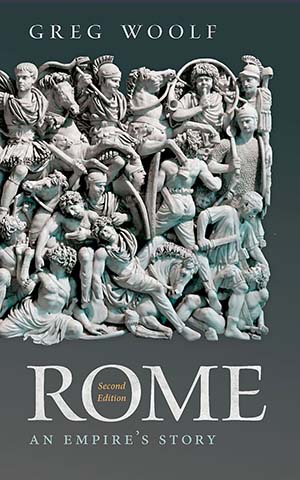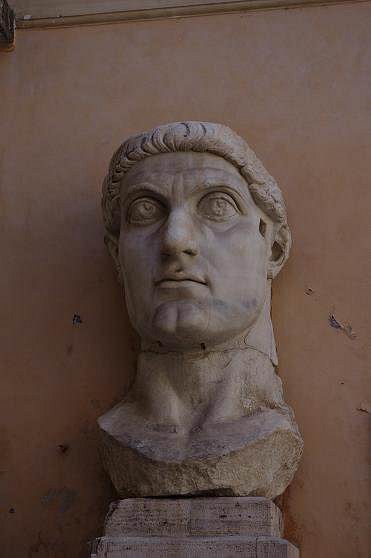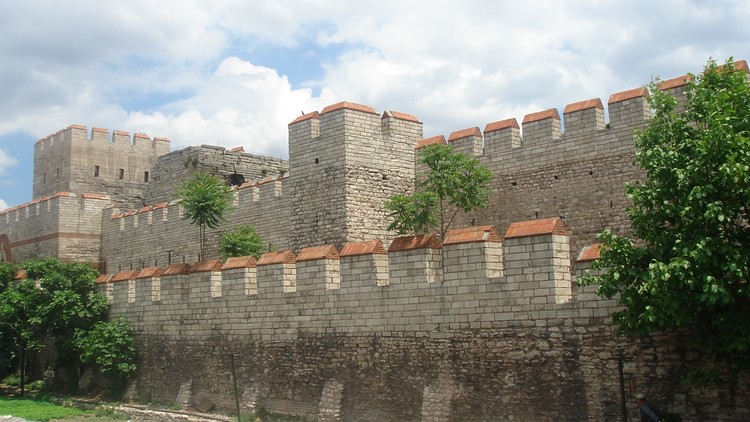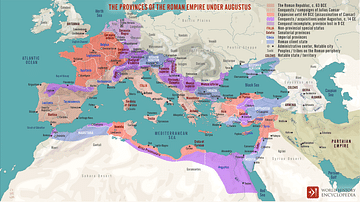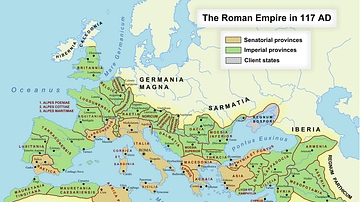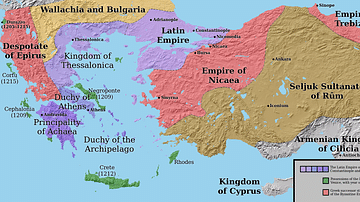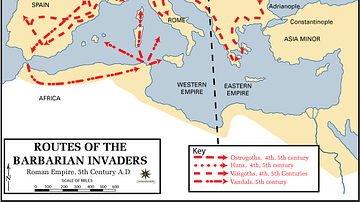Constantinople at first had much in common with the temporary capitals of the 2nd and 3rd century CE and the tetrarchic capitals. It was an existing city of medium size, well located on the road network, and unlike most of them, it was also well connected by water. It sat on the Sea of Marmara, which opened onto the Black Sea to the north and the Mediterranean to the south. It was close enough to the Danube frontier to keep track of war on that front, and not too far from the territories most often disputed with Persia.
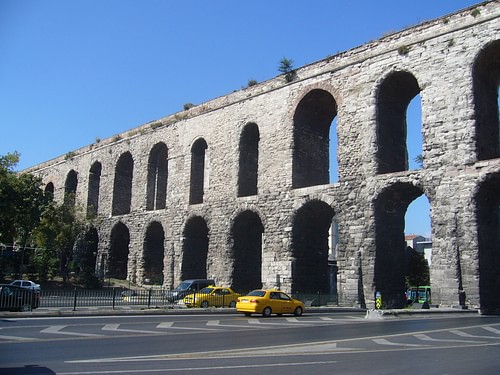
The Greek name for the city was Βυζαντιον (Byzantium), and this was what Greek writers such as Procopius continued to call it. Byzantium had withstood a major siege in the Severan civil war and then been rebuilt on an impressive scale, more than doubling its size. It would have made a good tetrarchic base, if Nicomedia were not already available about 150 kilometres (90 miles) away on the Asian side of the water. Why Constantine I (r. 306-337 CE) chose this site over Nicomedia is not known. Possibly, it was to avoid the Diocletianic associations, although Constantine had also built in Nicomedia and celebrated the 20-year anniversary of his reign there as well as in Rome. Perhaps the new city was a memorial of his victory over Licinius at nearby Chrysopolis in 324 CE, rather like Nikopolis created by Augustus (r. 27 BCE to 14 CE) to mark his victory at nearby Actium. Perhaps Constantine was attracted by the defensibility of the peninsula on which Byzantium stood and its excellent harbours.
Construction began late in 324 CE, and the 'new' city was inaugurated at a great ceremony in the Hippodrome in 330 CE. Much still remained to be completed, and building works were continuing at the time of Constantine's death seven years later, but the speed with which the new capital was conceived and created is impressive all the same. Constantinople dwarfed the earlier tetrarchic capitals in size. The city was refounded following ancient Roman rituals, and a new wall across the peninsula quadrupled the size of the Severan city.
At the eastern point, a great palace was built linked to the Hippodrome of Constantinople. Imperial thermae and processional ways were laid out. Great churches were constructed, including the cathedrals of Hagia Irene and Hagia Sophia. There were still some temples to the traditional gods. The city was also full of statues of gods taken from elsewhere, plunder and artworks to some observers, pagan idols to others. The Forum of Constantine and the Hippodrome were particularly ornately decorated. There were various nods to the city of Rome – seven hills, a Temple of Fortuna Romae – but in most respects, it was a fresh start. A new street grid was laid out in the new quarters (which never happened in Rome), and the city ringed with harbours and granaries. To populate the new megalopolis, a new population was drafted in, and a second Senate was created. Aqueducts and immense cisterns provided drinking water and supplied the baths of Zeuxippus. Egyptian grain that used to go to Rome was diverted to feed Constantinople. The Church of the Apostles may not have been completed in Constantine's lifetime, but he was buried in the adjacent mausoleum. Tetrarchs had created administrative bases with all the ceremony that late antique governance required, but Constantine had quite deliberately created a new symbolic centre for the empire.
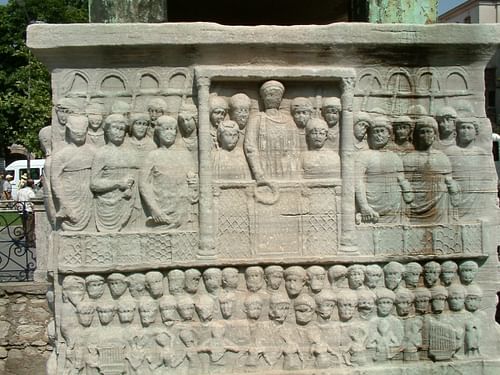
Constantine's plans were grandiose enough, but Constantinople soon expanded beyond his original design. Much of Constantius' reign was spent completing and filling out the original design, providing the city with a full set of institutions and perhaps making it more evidently an imperial capital. Some of this can be observed through the speeches of the orator and teacher Themistius, who was raised to the eastern Senate in 355 and then entrusted by the emperor with increasing its numbers until they were equal to those of the Senate of Rome. The city acquired an Urban Prefect, as Rome had, at some point in the middle of the 4th century CE. Successive panegyrics delivered by Themistius suggested (or claimed) a role for the eastern Senate in legitimizing the emperor. Meanwhile, the city continued to expand westwards. Yet another massive outer wall circuit was built early in the reign of Theodosius II, creating a great eastwards extension within which market gardening, residences, and religious foundations could be protected. The city centre became filled with churches, many of which would be rebuilt on a spectacular scale by Justinian.
Constantinople rose at Rome's expense. Imperial resources were redirected to the new capital. The new senate was partly filled with members of older families invited to come east, incentives for building accommodation drew architects, craftsmen, and capital to Constantinople, and the reduction of state grain made it more difficult for Rome to sustain its population levels. Zosimus was scathing about the waste of resources on the new capital, while Eusebius praised Constantine's religious foundations there. Probably this reflects some controversy around the end of Theodosius II's reign (r. 408-450 CE). But at the start of Constantine's reign, he certainly did not neglect Rome. Because imperial building projects always took many years to realize, both cities were still receiving his patronage at the time of his death. Indeed, throughout the 4th century CE and for a while afterwards, the empire had two symbolic centres, two Romes.
After the defeat of Maxentius in October 312 CE, Constantine behaved very much like other winners of civil wars, especially Augustus, Vespasian, and Septimius Severus. Each of these had used building projects in Rome to lay out a programme of sorts for their reigns. The most novel structures initiated by Constantine were a series of great basilical churches around the city. St. John Lateran, begun within a year of his victory and probably completed by 320 CE, was intended as a cathedral for the Christian community of Rome. Throughout the remainder of his reign, he and his relatives sponsored a number of other grand churches near the graves of martyrs located in the cemeteries around the city. The churches of Saint Lawrence outside the walls, of Saint Agnes, of Saints Marcellinus and Peter the Deacon and Old Saint Peter's on the Vatican and Saint Paul outside the walls ringed the city, providing facilities for pilgrims and local Christian communities.
There is a debate over how far the location of these churches was directed by the location of the tombs of the martyrs, how far by a sense of tact towards worshippers of the traditional gods whose temples were mostly in the city centre. There were good practical reasons for locating the basilicas where they were; some at least were on imperial ground. How tactful these vast structures were, when they were visible to most entering or leaving the city, is less clear. The construction of Old St. Peter's and St. Paul's probably began around the same time as work started at Constantinople. Constantine's building in Rome was not limited to churches. He built another set of Roman baths, probably quite early in his reign, to rival those of Trajan, Caracalla, and Diocletian. He remodelled the recent basilica of Maxentius on the Forum Romanum and installed a colossal statue of himself in it. There were restorations of the Forum Boarium and the Circus Maximus. Constantine was the last emperor, however, to spend significantly on the city.
The city of Rome remained a major symbolic centre right up to the Ostrogothic kingdom. The later 4th century CE in particular is exceptionally well documented by Christian writers and members of the senatorial order (the two groups increasingly overlapping, of course), and the culture, society, and politics of the city have been very well explored. The widespread shock at the Gothic sack of Rome 410 CE is proof enough that Rome still mattered across the empire. But its centrality altered over time. Most obviously, it never again became a political capital or even the capital of an Italian entity before the end of the 19th century.
The Senate continued to meet, and led by the Urban Prefect, continued to run the city as a rather grand town council, and senatorial priestly colleges continued to perform customary rituals until they were forbidden in the late 4th and early 5th centuries CE. But the decision-making functions were local, and important matters had to be referred to the Praetorian Prefect and the imperial court. All the same, the senatorial aristocracy found they were able, once again, to take possession of their city. During the 4th century CE, they took responsibility for the urban fabric, set up statues of themselves throughout the public spaces, and very occasionally welcomed imperial visitors in style.
Economically, the story is more complex. The families that filled the western Senate owned, collectively, a vast amount of land and other assets, especially in the west. During the 4th century CE, some contributed financially to the running of the city and the upkeep of its monuments, and many lived in splendid homes. But over time their wealth came under pressure from two directions. Neither of them, surprisingly enough, was the cash-strapped imperial court. One pressure, difficult to quantify precisely, was the gifts made by these families to religious foundations. The scale of the gifts made by Melania the Younger in the early 5th century CE scandalized some, although most of the surviving testimony praises her. It is notable, however, that during the 5th century CE, there is less and less sign of money being spent on repairs and restorations of any buildings not connected to the Church.
The second area of pressure was the occupation of so much of the west, first by settled barbarian 'guests' and later by the new kingdoms. Alongside these pressures on the wealth of the propertied classes, there was the shrinkage of the population of the city, in part no doubt a response to reduced supplies of subsidized grain, in part a sign that commercially Rome was no longer as important a market as before. Yet alongside these changes is the growth of the wealth of the Christian Church, the building activities and growing influence of the bishops of Rome from Damasus in the late 4th century CE to Leo the Great in the 5th.
If the 4th century CE had been dominated by the dynamics of the relationship between Senate and distant court, then from the 5th century CE on, the relationship between Pope and aristocracy would begin to shape the public life and public spaces of the city. This political mix was quite different in Constantinople, where Christian ceremony was increasingly bound up with that of emperors, who were mainly physically present in the city, and where the eastern Senate collectively had much less influence. Meanwhile, as Rome shrank in size, Constantine's new capital grew and grew adding new districts and new wall circuits during the 5th century CE.
The empire had other centres. One of them was the person of the emperor itself. Those rare imperial ceremonial visits to Rome had such a charge because two centres were for an instant brought into contact. At Constantinople, the emperor and the city coincided more regularly and mostly harmoniously, although the Nika riots illustrate how badly proximity could go wrong. As for other urban centres, the ancient cities of Antioch, Alexandria, and Carthage continued to play their parts in regional exchange systems. The capture of Carthage by the Vandals in 439 CE did not entirely interrupt this. Despite repeated attempts to recapture the city, the Vandals ruled there until Justinian's general Belisarius reconquered it in 534 CE. Antioch remained a major hub, too, until the early 6th century CE, when a devastating earthquake was followed a few years later by a Persian attack which left the city depopulated. Justinian tried to revive it, but with limited success. Alexandria too passed briefly into Persian and then back to Roman hands during the early 7th century CE. Antioch fell to the Arab invasions in 637 CE, Alexandria in 641 CE, and Carthage in 697 CE.
Then there was Jerusalem, too, a medium-sized Roman colony since the reign of Hadrian (r. 117-138 CE), then the third focus of Constantinian building after Rome and Constantinople. The Church of the Holy Sepulchre, incorporating another great basilica, was constructed in the last years of Constantine's reign. The site became an early centre for Christian pilgrimage. During the reign of Theodosius II, the Bishop of Jerusalem was recognized as a Patriarch, which gave him equal status to that of the bishops of Constantinople, Antioch, Alexandria, and (in the eyes of some) Rome. Justinian (r. 527-565 CE) built two new great churches there, the New Church of the Theotokos (the Mother of God) and the Church of Sion. Jerusalem too was caught up in the wars with Persia of the early 7th century CE and fell to the Arabs in 638 CE.
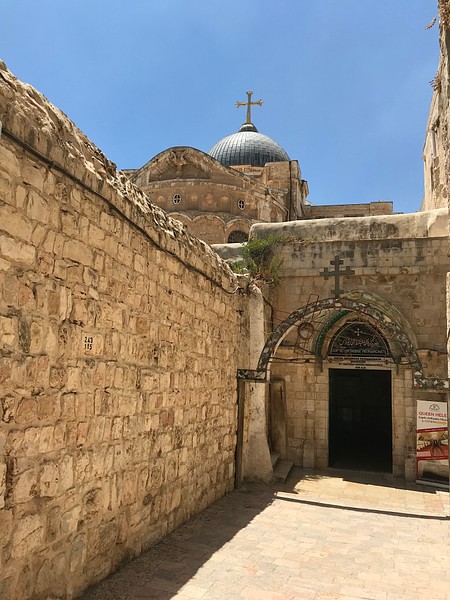
The processes which led to Constantinople becoming the unrivalled capital of the Roman world were tortuous ones and were not really the result of any planned centralization. In some ways, it makes more sense to think of how the shifting political and military geography and the changing patterns of economic and cultural activity impacted on the urban networks of the empire. The Roman Empire began as a single city-state, and it ended the same way, even if it did not contract to the same point from which it had expanded. For most of its history, the empire was too large and complex an enterprise to be steered from any single centre.
